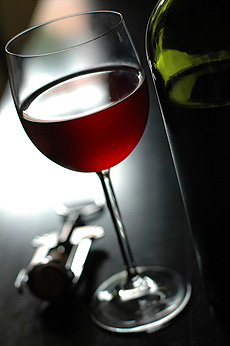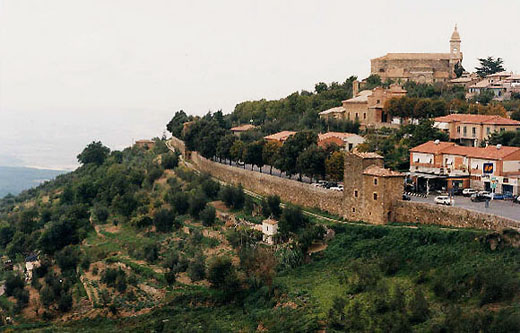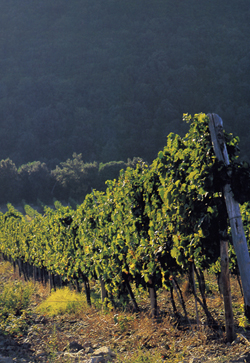
 Enjoying a glass in Montalcino. Photo by Dušan Zidar | BSP.
Enjoying a glass in Montalcino. Photo by Dušan Zidar | BSP.
|
KRIS PRASAD is Wine Editor of THE NIBBLE.
|
|
April 2008 |
 |
Product Reviews / Main Nibbles / Wine Brunello di Montalcino:
The Best Of The 2003 Vintage
CAPSULE REPORT: The 2003 growing season was a scorcher in Europe. Hot weather is good for producing rich, ripe fruit; scorching weather tends to produce overripe, jammy fruit. Yet, those grown at higher altitudes, like Brunello, can fare better. THE NIBBLE’s wine editor tasted the vintage and reports back. It may not be the four-star vintage the Consorzio claims, but there certainly were wines to add to his collection.
Brunello is a clone of Sangiovese, the grape that forms the backbone of the more widely-known Chianti wines. It comes from hills around the town of Montalcino, barely 15 miles south of Sienna, a destination for many tourists who may not even know that the town for wine pilgrims is so close by.
While the town itself has been around for centuries, the emergence of Brunello, also called Sangiovese Grosso, has been more recent. From less than 25 growers/winemakers in the early 1970s, the appellation has grown to nearly 300 growers making wine, from land reclaimed from scrub or transformed from orchards. The wine itself has been transformed from lean and edgy, but distinctively perfumed (a classic style reminiscent of Chianti but with depth), to a more modern, rich, plummy and broad style, with an eye towards immediate appeal (that is to say, early drinking—no long aging required).
Both styles of winemakers can be found in the Consorzio del Vino Brunello di Montalcino, the Brunello winegrowers’ and winemakers’ consortium. There are good interpreters of modernism, where some modicum of respect for terroir is present. But there are also those, who in the name of modernism, who pander to consumers barely weaned from cola bottles, and those whose wines are barely distinct from Australian shiraz. All styles were on display at the Consorzio’s presentation of the wines of the 2003 vintage.
 |
| The picturesque town of Montalcino. Photo courtesy of Consorzio del Vino Brunello di Montalcino. |
2003 Tasting Notes
The 2003 growing season, as is well known, was scorching all over Europe. But the hillside vineyards of Montalcino were able to compensate with cooler evening temperatures, particularly if the vineyards were over 2,500 feet above sea level.
Nearly 45 winemakers belonging to the Consorzio del Vino Brunello di Montalcino previewed their four-star rated vintage for members of the trade and press recently in New York City. I managed to taste nearly 30 of the 45 or so wines at the tasting. Most of the wines showed surprising freshness and, while showing intense fruit, never came close to being jammy, as I was expecting at the outset from such a hot vintage. But most did lack a cohesiveness and probably will never be “complete” wines. It needs to be seen if this vintage deserves to be rated four stars.
Yet, five wines impressed me very much, and others ranged from well-made to very good. These five wines I can recommend wholeheartedly as exceptional for the vintage. In looking back it is not surprising that 4 of the 5 wines that I liked best were located north of the town of Montalcino where somewhat cooler temperatures prevailed. These are five wines I would gladly add to my cellar.
Those wines that I thought highly of are discussed below. I also have tasting notes on Brunello of the excellent 2001 vintage at wine-lovers-club.blogspot.com.
Capanna: I rated this wine four stars out of five. It was my favorite of the 2003 Brunellos at the tasting. Unlike all of the others this wine was less about the intensity of fruit, and more about balance and style. Acids and dry tannins nicely frame the fruit, with a clean rather than hot finish. The 2001 vintage, tasted several months earlier, was similarly impressive.
Cupano: The 2003 Cupano was my second favorite Brunello. Unfortunately, my notes are illegible other than the phrase, “slightly modern but restrained”—one of the perils of tasting thirty wines in less than two hours. But I have four stars noted next to it.
Gianni Brunelli: The 2003 is atypically light on its feet, which is a plus in this vintage. This is a nicely-shaped wine with good definition and, unusual for a 2003 wine, aromatically pitched. I liked this quite a bit. |

Vines planted at the base of the hill; the town of
Montalcino is at the top.
|
La Serena: One of the better 2003 Brunellos, showing character in spite of the huge alcohol. It’s surprisingly restrained, with a deliciously dry aftertaste. Coming from a cool northern zone, albeit at lower altitude, it appeared to benefit from slower ripening. This wine is fresh and nicely structured.
Nardi: A touch more advanced than the other wines at the tasting. Yet, there was a lot to like about the cool and brambly fruit. I liked its restraint very much; this wine is very likely to gain in complexity and transcend the 2003 character of intense dryness and imbalanced alcohol.
I also liked the 2003 Brunellos from Il Maronetto, Pinino and Sesti.
Brunello lovers will do well to purchase these wines. For an in-depth overview of Brunello, click on the link below.
Lifestyle Direct, Inc. All rights reserved. Images are the copyright of their respective owners.

|
|






